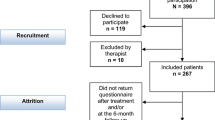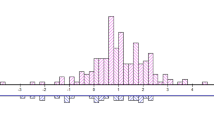Abstract
Objective In most industrialized countries, disability benefit rates have increased substantially in the past decade. Few beneficiaries return into employment once disability benefit is awarded. The present study aims to investigate which factors predict functional improvement and future work status among persons claiming disability benefit after having been on long-term sickness leave. Methods Prospective cohort study with 1 year follow-up among disability claimants (n = 375; response rate: 24.3 %) conducted in the Netherlands (October 2008–April 2011). Logistic regression was used to analyze associations between predictors [demographics; outcomes of the 12-item General Health Questionnaire (GHQ-12); 10-item Kessler Psychological Distress scale; Alcohol Use Disorders Identification Test; Trimbos/iMTA questionnaire for Costs associated with Psychiatric Illness; Utrecht Coping List; Social Support Questionnaire for Transactions and Satisfaction; certified International Classification of Diseases 10th edition (ICD-10) diagnosis; loss of earning capacity (LEC)] and outcomes [functional improvement on the World Health Organization Disability Schedule 2.0 (WHODAS 2.0) exceeding the standard error of measurement; work status at follow-up]. Results Functional improvement on total WHODAS was reported by 84 (31.9 % of 263 claimants included in analysis). Of those not having work at baseline (n = 338), 34 (9.1 %) respondents had paid work 1 year later. Predictors of functional improvement: GHQ-12 sum score >20 [odds ratios (OR) 2.9; 95 % confidence intervals (CI) 1.54–5.34]; of future work status: work status at baseline (OR 16.8; 95 % CI 6.55–43.14), LEC < 80 % (OR 4.6; 95 % CI 1.87–11.42), contact with a medical specialist (OR 0.4; 95 % CI 0.19–0.87). Conclusions Only a limited number of factors were found to significantly predict functional improvement and return to paid work after the disability benefit claim, having paid work at baseline being by far the most important factor.
Similar content being viewed by others
References
OECD. Sickness, Disability and Work: keeping on track in the economic downturn—background paper. 2009. http://www.oecd.org/dataoecd/42/15/42699911.pdf. Accessed 5th Jan 2012.
UWV factsheet (in Dutch). Amsterdam, 2011. http://www.uwv.nl/overuwv/Images/111031%20Factsheet.pdf. Accessed 5th Jan 2012.
Henderson M, Glozier N, Holland EK. Long term sickness absence. BMJ. 2005;330:802–3.
Hashemi L, Webster BS, Clancy EA. Trends in disability duration and cost of workers’ compensation low back pain claims (1988–1996). J Occup Environ Med. 1998;40:1110–9.
de Boer WEL, Besseling JJM, Willems JHBM. Organisation of disability evaluation in 15 countries. Pratiques et organisation des soins. 2007;38:205–17.
Muijzer A, Groothoff JW, de Boer WE, Geertzen JH, Brouwer S. The assessment of efforts to return to work in the European Union. Eur J Public Health. 2010;20:689–94.
Krause N, Frank JW, Dasinger LK, Sullivan TJ, Sinclair SJ. Determinants of duration of disability and return-to-work after work-related injury and illness: challenges for future research. Am J Ind Med. 2001;40:464–84.
Steenstra IA, Verbeek JH, Heymans MW, Bongers PM. Prognostic factors for duration of sick leave in patients sick listed with acute low back pain: a systematic review of the literature. Occup Environ Med. 2005;62:851–60.
Duijts SF, Kant I, Swaen GM, van den Brandt PA, Zeegers MP. A meta-analysis of observational studies identifies predictors of sickness absence. J Clin Epidemiol. 2007;60:1105–15.
Dekkers-Sanchez PM, Hoving JL, Sluiter JK, Frings-Dresen MH. Factors associated with long-term sick leave in sick-listed employees: a systematic review. Occup Environ Med. 2008;65:153–7.
Blank L, Peters J, Pickvance S, Wilford J, Macdonald E. A systematic review of the factors which predict return to work for people suffering episodes of poor mental health. J Occup Rehabil. 2008;18:27–34.
Cornelius LR, van der Klink JJ, Groothoff JW, Brouwer S. Prognostic factors of long term disability due to mental disorders: a systematic review. J Occup Rehabil. 2011;21:259–74.
Wallman T, Wedel H, Johansson S, et al. The prognosis for individuals on disability retirement. An 18-year mortality follow-up study of 6887 men and women sampled from the general population. BMC Public Health. 2006;6:103.
Øverland S, Glozier N, Henderson M, Mæland JG, Hotopf M, Mykletun A. Health status before, during and after disability pension award: the Hordaland Health Study (HUSK). Occup Environ Med. 2008;65:769–73.
Cornelius LR, Groothoff JW, van der Klink JJL, Brouwer S. The performance of the K10, K6 and GHQ-12 to screen for present state DSM-IV disorders among disability claimants. BMC Public Health. 2013;13:128.
UWV Quarterly Report 2006-IV (in Dutch: Kwartaalverkenning 2006—IV). Amsterdam; 2007. http://www.rwi.nl/CmsData/File/UWV%20Kwartaal%202006-IV.pdf.Accessed 10th Jan 2012.
Goldberg D, Williams p. A user’s guide to the General Health Questionnaire. Windsor: NFER-NELSON; 1998.
Schmitz N, Kruse J, Tress W. Psychometric properties of the General Health Questionnaire (GHQ-12) in a German primary care sample. Acta Psychiatr Scand. 1999;100:462–8.
Donker T, Comijs H, Cuijpers P, Terluin B, Nolen W, Zitman F, Penninx B. The validity of the Dutch K10 and extended K10 screening scales for depressive and anxiety disorders. Psychiatry Res. 2010;176:45–50.
Kessler RC, Andrews G, Colpe LJ, Hiripi E, Mroczek DK, Normand SL, Walters EE, Zaslavsky AM. Short screening scales to monitor population prevalences and trends in non-specific psychological distress. Psychol Med. 2002;32:959–76.
Kessler RC, Barker PR, Colpe LJ, Epstein JF, Gfroerer JC, Hiripi E, Howes MJ, Normand SL, Manderscheid RW, Walters EE, Zaslavsky AM. Screening for serious mental illness in the general population. Arch Gen Psychiatry. 2003;60:184–9.
Reinert DF, Allen JP. The Alcohol Use Disorders Identification Test: an update of research findings. Alcohol Clin Exp Res. 2007;31:185–99.
Hakkaart-van Roijen L. Handleiding Trimbos/iMTA questionnaire for Costs associated with Psychiatric Illness (TiC-P). Rotterdam: Institute for Medical Technology Assessment; 2002.
Schreurs KM, van den Willige G, Brosschot JF. De Utrechtse Coping Lijst [Utrecht Coping Questionnaire]. Lisse: Swets and Zeitlinger;1993.
Sanderman R, Ormel H. The Utrecht coping list: validity and reliability (in Dutch: De Utrechtse Coping Lijst (UCL): Validiteit en Betrouwbaarheid). Gedrag en Gezondheid. 1992;20:32–7.
Doeglas D, Suurmeijer T, Briancon S, Moum T, Krol B, Bjelle A. An international study on measuring social support: interactions and satisfaction. Soc Sci Med. 1996;43:1389–97.
World Health Organization. International Statistical Classification of Diseases and Related Health Problems 10th Revision (ICD-10). See: http://apps.who.int/classifications/icd10/browse/2010/en. Accessed Apr 19th 2012.
Ouwehand P, Wouters PHM. CAS, classificaties voor Arbo en SV (CAS, classification for occupational health and social security). Amsterdam: UWV; 2002.
Üstün TB, Kostanjsek N, Chatterji S, Rehm J Measuring Health and Disability Manual for WHO Disability Assessment Schedule WHODAS 2.0. Geneva: World Health Organization; 2010.
McLeod LD, Coon CD, Martin SA, et al. Interpreting patient-reported outcome results: US FDA guidance and emerging methods. Expert Rev Pharmacoecon Outcomes Res. 2011;11:163–9.
de Vet HC, Terwee CB, Knol DL, et al. When to use agreement versus reliability measures. J Clin Epidemiol. 2006;59:1033–9.
Saunders JB, Aasland OG, Babor TF, de la Fuente JR, Grant M. Development of the Alcohol Use Disorders Identification Test (AUDIT): WHO collaborative project on early detection of persons with harmful alcohol consumption–II. Addiction. 1993;88:791–804.
Vlasveld MC, van der Feltz-Cornelis CM, Bültmann U, Beekman ATF, van Mechelen W, Hoedeman R, Anema JR. Predicting return to work in workers with all-cause sickness absence greater than 4 weeks: a prospective cohort study. J Occup Rehabil. 2012;22:118–26.
Brouwer S, Krol B, Reneman MF, Bultmann U, Franche RL, van der Klink JJ, et al. Behavioral determinants as predictors of return to work after long-term sickness absence: an application of the theory of planned behavior. J Occup Rehabil. 2009;19:166–74.
Franche RL, Krause N. Readiness for return to work following injury or illness: conceptualizing the interpersonal impact of health care, workplace, and insurance factors. J Occup Rehabil. 2002;12:233–56.
Selwin S, Audhoe SS, Hoving JL, Nieuwenhuijsen K, Friperson R, de Jong PR, Sluiter JK, Frings-Dresen MHW. Prognostic factors for the work participation of sick-listed unemployed and temporary agency workers with psychological problems. J Occup Rehabil. 2012;22:437–46.
Anema JR, Van Der Giezen AM, Buijs PC, van Mechelen W. Ineffective disability management by doctors is an obstacle for return-to-work: a cohort study on low back pain patients sicklisted for 3–4 months. Occup Environ Med. 2002;59:729–33.
Statistics Netherlands (in Dutch: Centraal Bureau voor de Statistiek). The Haque, the Netherlands, 2013. http://www.cbs.nl/NR/rdonlyres/D88D873A-C69B-46E0-AD7D-444F5C56F5B8/0/pb13n021.pdf. Accessed Mar 27 2013.
Langerak W, Langeland W, Draijer N, Draisma S, van Balkom T. Diagnostics and classification of psychiatric disorders in a cohort of long-term work disabled persons due to mental health problems (in Dutch: Diagnostiek en classificatie van psychiatrische aandoeningen bij een steekproef van langdurig psychisch arbeidsongeschikten). Tijdschr Bedrijfs Verzekeringsgeneeskd. 2011;19:14–21.
Cornelius LR, van der Klink JJL, Brouwer S, Groothof JW. Under-recognition and under-treatment of DSM-IV classified mood and anxiety disorders among disability claimants. Disabil Rehabil. 2013; doi: 10.3109/09638288.2013.833310.
Acknowledgments
This research project was funded by the Social Security Institute, the Netherlands. The funding institute had no role in the design, collection, analysis, and interpretation of data; in the writing of the manuscript; and in the decision to submit the manuscript for publication.
Author information
Authors and Affiliations
Corresponding author
Rights and permissions
About this article
Cite this article
Cornelius, L.R., van der Klink, J.J.L., de Boer, M.R. et al. Predictors of Functional Improvement and Future Work Status After the Disability Benefit Claim: A Prospective Cohort Study. J Occup Rehabil 24, 680–691 (2014). https://doi.org/10.1007/s10926-014-9500-2
Published:
Issue Date:
DOI: https://doi.org/10.1007/s10926-014-9500-2




